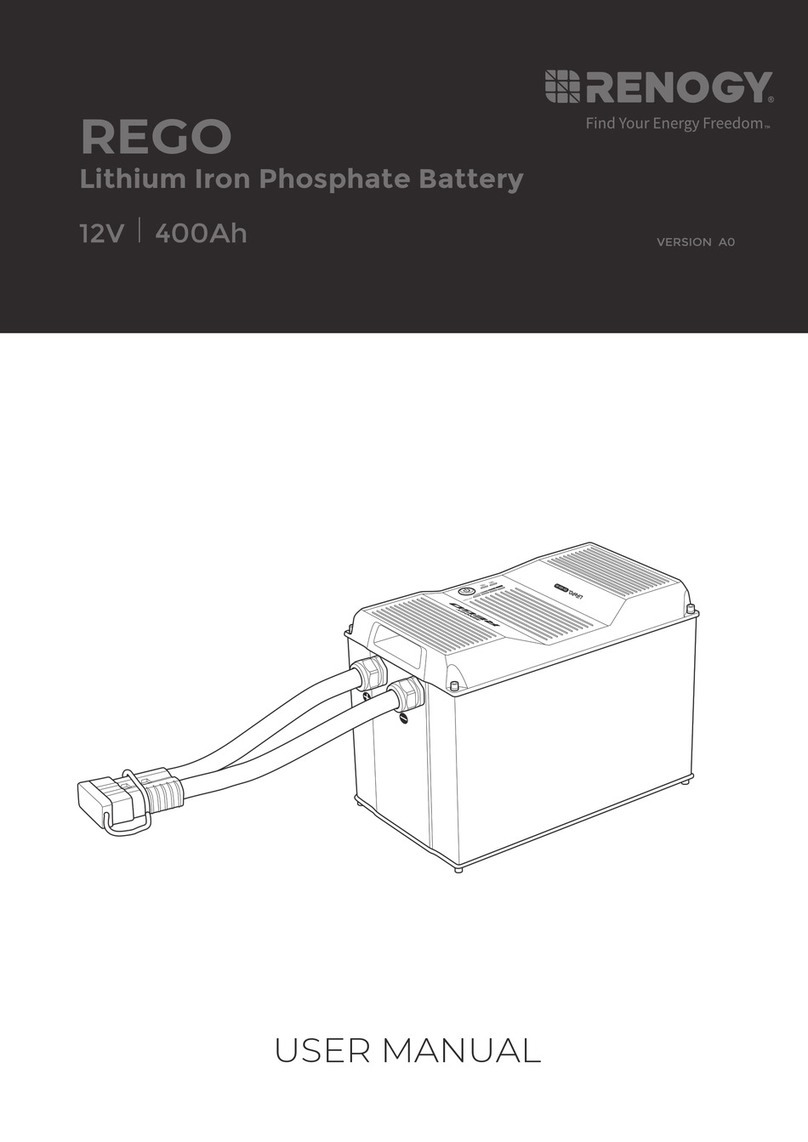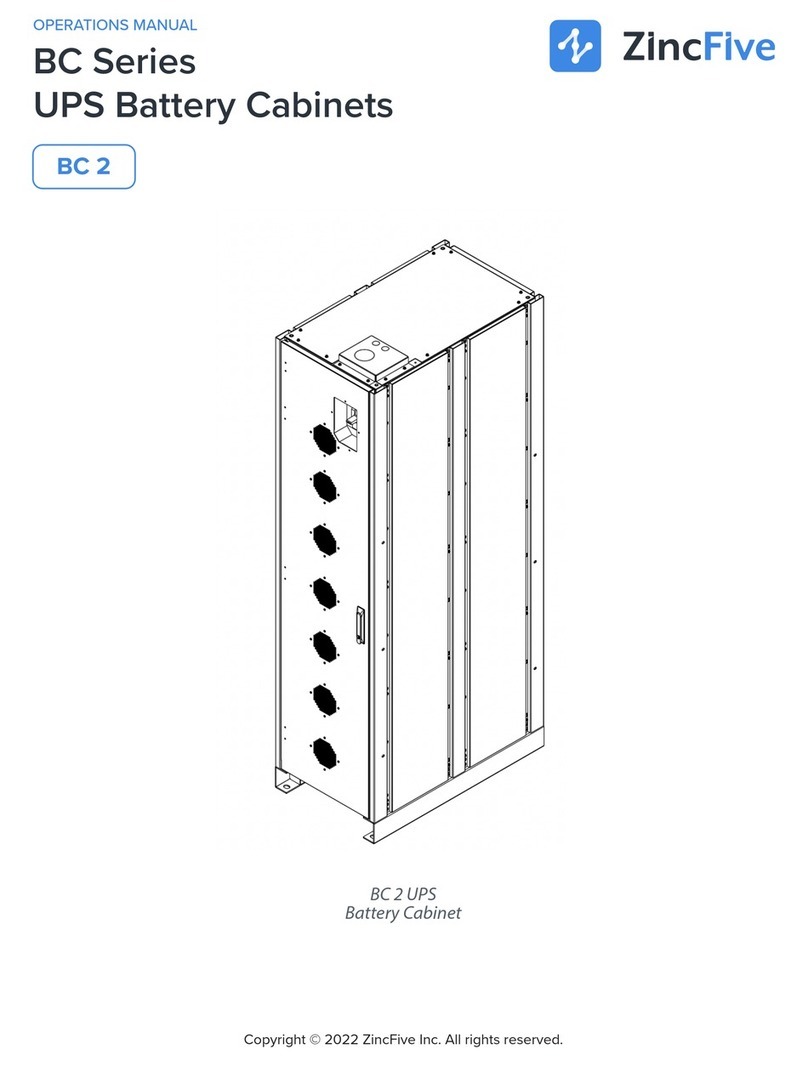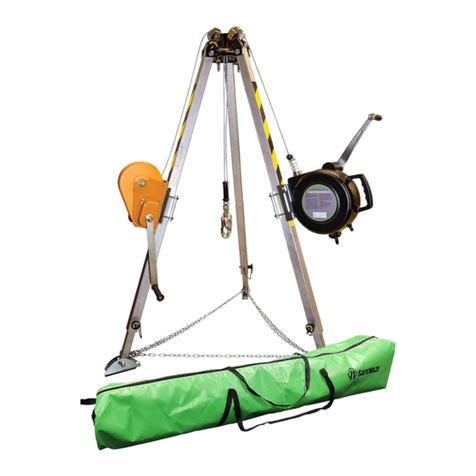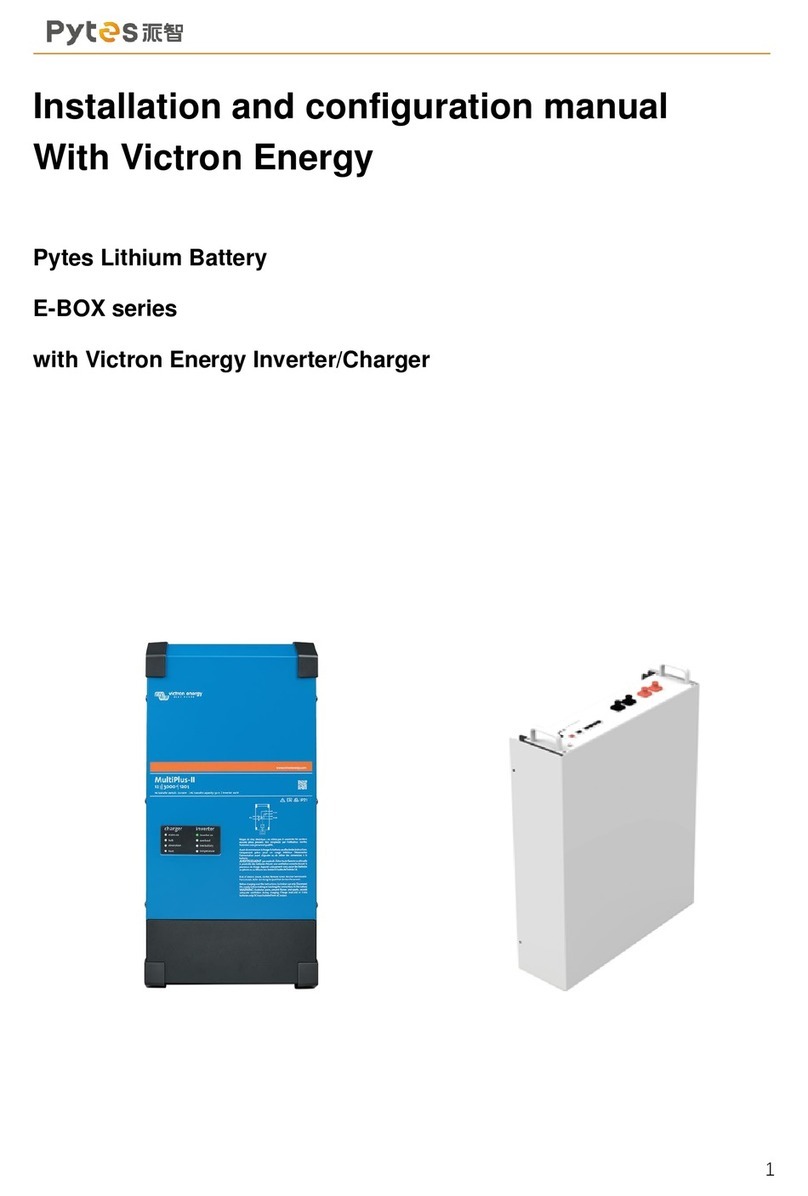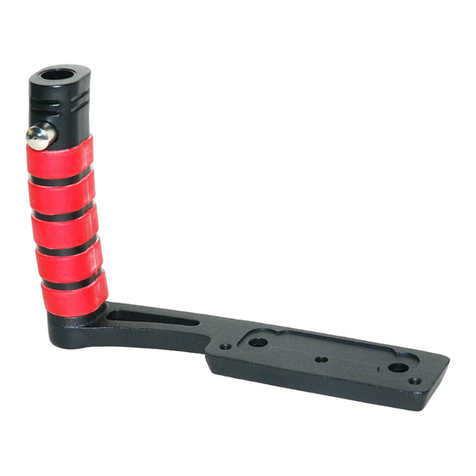Endurance Polaris Lithium Series User manual


INDEX
1. General aspects of the battery............................................................................1
a. Composition. .........................................................................................................1
b. Configuration of the charger with the battery.....................................................1
2. Declaration of conformity....................................................................................2
3. Security..................................................................................................................3
4. Information on composition.................................................................................4
5. First-aid measures in case of exposure to internal battery components.........4
6. Measures in case of fire........................................................................................5
7. Accidental release measures...............................................................................6
8. Use of personal protective equipment. ...............................................................6
a. Under normal conditions......................................................................................6
b. After an incident....................................................................................................7
9. Stability and reactivity. .........................................................................................7
10. Toxicological information. ...............................................................................7
11. Procedure for disposal of lithium-ion batteries. ............................................7
12. Transport information.......................................................................................8
a. General...................................................................................................................8
13. Battery specifications.......................................................................................9
a. Battery components..............................................................................................9
14. Battery types.....................................................................................................9
15. Labelling..........................................................................................................10
16. Installation.......................................................................................................10
17. Manipulation....................................................................................................11
18. Start up. ...........................................................................................................11
a. S-BMS Model. ......................................................................................................13
b. C-BMS Model.......................................................................................................13
19. Connecting the display...................................................................................13
a. Operation. ............................................................................................................13
b. Icons.....................................................................................................................14
c. Wifi hotspot configuration..................................................................................14

d. Data verification. .................................................................................................15
20. Charge..............................................................................................................15
21. Storage.............................................................................................................16
22. Maintenance....................................................................................................17
a. Preventive............................................................................................................17
i. Maintenance procedure......................................................................................17
.......................................................................................................................................17
ii. Mode of protection..............................................................................................17
b. Corrective.............................................................................................................18
23. Repairs.............................................................................................................19
24. Warrenty. .........................................................................................................19

1
1. General aspects of the battery.
Keep the instructions for future reference and the manual within
easy reach of anyone who will be using the battery. the battery.
Installation may only be carried out by Endurance Motive S.A.
authorised personnel.
a. Composition.
The energy storage of our Polaris Lithium batteries is based on Lithium Ferrophosphate
(LiFePO4) cells, certified by UN38.3/MSDS, RoHS, CE, TUV and UL with high safety.
The cell cover material is flame retardant and has a ceramic diaphragm pressure valve
for increased safety.
It also has a BMS (battery management system) that provides intelligent action for
charging, discharging and monitoring.
The BMS monitors that limit values are respected, and in case of malpractice, protects
the battery against critical conditions.
Our batteries are designed for electric forklift trucks and material handling equipment for
indoor use.
It has its own IP65 steel enclosure designed to withstand the temperatures and pressures
encountered during normal use.
It is delivered with the ballasted case, designed for a specific forklift truck model, which
complies with the forklift truck manufacturer's recommendations.
The Polaris Lithium battery is designed for a specific model of forklift
truck and should not be used in other models.
b. Configuration of the charger with the battery.
The batteries mentioned in this manual are supplied together with a CAN charger, which
are pre-configured.
A specific charger supplied by Endurance Motive S.A. must be used for charging which,
in turn, will be controlled from the Polaris Lithium battery via the CAN interface.
If you own or purchase a charger with CAN Bus communication protocol, there should
be no incompatibility, as long as the CAN Bus standard between the battery and the
charger is respected
In case of incompatibility and/or problems, Endurance Motive S.A. will be able to provide
information on the communication protocol used.
In general, the capacity demand of a lithium-ion battery is lower than that of an equivalent
lead-acid battery. This is because it has fewer losses.
!
CARE
!
ATTENTION

2
2. Declaration of conformity.
Manufacturer:
Address:
Endurance Motive S.A
St. La Bernia 1, 46529 Canet de berenguer - Valencia - Spain
Date:02-01-2022
Endurance Motive S.A. declares that the list ofproducts below complies with the
relevant European Union harmonisation legislation and bears the CE marking in
accordance with the following directives:
Electromagnetic compatibility (EMC) 2014/30/UE
Directive RoHS 2011/65/EU
Low Voltage Directive 2014/35/EU
Product safety device 2001/95/CE
Directive 2006/66/CE
Including amendments thereto
References to the relevant harmonised standards used or references to other
technical specifications in relation to which conformity is declared:
UNE-EN 62619:2017
IEC62620:2014
IEC62133:2012
EN6100063:2007A1:2011
EN61000-63:2007A1:2011
Type of equipment:
Battery with external charger.
Carlos Navarro(CEO)

3
3. Security.
The Polaris Lithium battery system is non-hazardous when used
in accordance with the recommendations in this manual. All staff
must receive adequate information and training on the correct
use and operation of these.
Please note the following warnings before using the battery.
▪The Polaris Lithium battery must only be used in the appropriate forklift truck, with
the weight and voltage described on the label and in accordance with the forklift
truck manufacturer's requirements. Improper use may result in damage to both the
forklift truck and the user of the forklift truck.
▪Do not use the Polaris Lithium battery if it is damaged. Do nothandle damaged parts
and contact Endurance Motive S.A. service personnel.
▪Use extreme caution when handling the external battery connection cables to avoid
short circuits between the external battery terminals and the contacts. A short circuit
can cause fire, property damage and serious injury.
▪The external connector is designed to mate with the machine and charger in the
correct way; therefore, avoid:
- Forcing the connections.
- Removing the connector by pulling on the cable.
- Tampering with the connector by unauthorised personnel.
- Because it has an IP21 degree of protection, it must not get wet.
▪The Polaris Lithium battery must only be connected to the appropriate charger that
has been configured for charging the Polaris Lithium battery. Do not use any other
charger, as this may damage the Polaris Lithium battery and/or cause injury.
▪Do not stand or lean on the Polaris Lithium battery.
▪Do not open the Polaris Lithium battery to gain access to the interior.
▪Use only the cables supplied by Endurance Motive S.A. In the event of damage to
the cables, replacement cables must be ordered from Endurance Motive S.A.
▪Only authorised personnel must carry out the installation or removal of the battery.
▪The product must not be disassembled.
Do not short-circuit, puncture, incinerate, crush, immerse inwater
or expose to temperatures outside the range specified by the
manufacturer. If this occurs, electrolyte leakage, explosion or fire
of the battery may occur, depending on the circumstances. In the
event of a prolonged short-circuit, the battery may reach high
temperatures, emitting gases and a fire may be generated.
Any damage to the battery caused by the actions described above
will invalidate the use of the warranty.
!
DANGER
!
ATTENTION
!
ATTENTION

4
If, due to external influences such as violence, fire, flooding, etc., it is not possible to
operate the system safely. In case of irregular phenomena, the following must be
taken into account:
▪The cells contain substances that are flammable when they reach the oxygen
in the air.
▪The cells contain substances that can form a flammable mixture with the air
after evaporation.
▪Cells contain substances that can react with water as soon as they reach the
humidity in the air or if water enters a cell.
▪These substances can be expelled if a cell is exposed to high pressure or
external fire, or if it is damaged by mechanical force.
▪The amount of these substances is so small that caution should only be
exercised in the immediate vicinity of the energy system.
4. Information on composition
The battery consists of a metal casing containing several sealed cells of lithium-ion
phosphate and other materials, which could be potentially hazardous if released.
SUBSTANCE
INDEX ca. %
CAS-Nr.
LITHIUM IRON PHOSPHATE
orr
31,0
15365-14-7
ALUMINIUM
8,0
7429-90-5
GRAFITO
18,0
7782-42-5
COPPER WIRE
12,0
7440-50-8
LITHIUM
HEXAFLUOROPHOSPHATE
4,0
21324-40-3
CARBONATE
8,0
-----
POLYPROPYLENE
19
9003-07-0
5. First-aid measures in case of exposure to internal battery
components.
Lithium-ion batteries contain compounds of lithium salts, organic solvents, etc.
If used improperly or inextreme environments, dangerous situations such as leakage,
smoke, overheating and opening of the safety valve (with spraying of black
substance), fire may occur. To protect the safety of personnel and reduce economic
losses, you must take urgent protective measures in case of danger.

5
Please read and carefully observe the following protection
recommendations:
SMOKE
INHALATION
When smoke is present, use protective measures (such as
covering your nose and mouth with a wet towel or wearing a
professional gas mask) to prevent smoke inhalation. Since
smoke and other noxious gases can damage the respiratory
system, administer oxygen if necessary. Move the victim to
fresh air and remove the source of contamination from the
area. In severe cases, seek medical treatment.
EYE
CONTACT
Rinse immediately with plenty of water for at least 15 minutes,
lifting the upper eyelid while rinsing. Rinse with saline solution
if possible. In severe cases, seek medical treatment.
SKIN
CONTACT
Remove any clothing you are wearing, wash thoroughly with
water. Seek medical treatment in severe cases.
INGESTIÓN
Drink milk/water and induce vomiting; seek medical care.
6. Measures in case of fire.
GENERAL
DANGER
A destructive impact can cause the battery to release internal
energy in an instant, causing a pressure release of the safety
valve, smoke, etc.
At temperatures above 120°C, the pressure valve may burst
and flammable gases may escape.
At this point, fire extinguishing measures must be taken.
LIGHT or
LARGE FIRE
In case of fire, flames or smoke:
▪while driving: stop, turn off the truck and leave the area
▪During charging: stop the charger or remove the charging
cable and leave the area.
▪Move the power system outdoors or to a well-ventilated area
and move people away from the area when possible.
▪Establish a 5 metre safety perimeter around the battery
▪Use extinguishing systems to isolate the system from the air
such as masking sand, carbon dioxide or dry powder
extinguishers or other extinguishers, and disconnect the
system at the same time. Avoid using water as it may
produce hydrogen fluoride.
!
ATENTTION

6
▪Call the emergency services and report that the fire has
been caused by a Lithium Ion battery.
After extinguishing the fire, do not use the battery again.
Contact the after-sales service department.
7. Accidental release measures.
MEASURES
TO BE
TAKEN IN
THE EVENT
OF
SPILLAGE
OR
LEAKAGE
OF
MATERIALS
▪If material is released from the battery, remove personnel from
the area until fumes dissipate.
▪Provide maximum ventilation to remove hazardous fumes.
▪Leave area and allow batteries to cool and vapours to
dissipate.
▪Avoid contact with skin and eyes or inhalation of vapours.
Remove spilled liquid with a cloth, then dispose of in a plastic
bag and place in a steel box.
Batteries must not be opened, destroyed or set on fire, as
they may leak or rupture and release the ingredients
contained in the hermetically sealed container into the
environment.
MANIPULATION
▪No special protective clothing is required for handling.
▪
▪The battery must be transported in its original
packaging or equivalent. The battery system must not
be opened, destroyed or set on fire.
▪Follow the manufacturer's recommendations for
maximum recommended currents and operating
temperature range using a dedicated charger.
8. Use of personal protective equipment.
a. Under normal conditions.
!
DANGER
!
DANGER

7
RESPIRATORY
PROTECTION
Not necessary under normal conditions of use.
PROTECTIVE
GLOVES
Not necessary under normal conditions of use.
EYE
PROTECTION
Not necessary under normal conditions of use.
OTHER
CLOTHING
Not necessary under normal conditions of use.
b. After an incident.
RESPIRATORY
PROTECTION
In the event of battery failure, provide as much ventilation as
possible. Avoid confined areas where batteries are vented.
PROTECTIVE
GLOVES
Use polypropylene, polyethylene, rubber or Viton gloves
when handling broken or leaking items.
EYE
PROTECTION
Wear safety goggles with side shields or a full face mask
when handling broken or leaking items.
OTHER
CLOTHING
Wear a rubber apron and protective clothing when handling
broken or leaking items.
9. Stability and reactivity.
REACTIVITY
None, beyond normal conditions
CONDITIONS TO
AVOID
Heating, mechanical and electrical abuse
MATERIALS TO
AVOID
None, beyond normal conditions
HAZARDOUS
DECOMPOSITION
PRODUCTS
None, beyond normal conditions
10. Toxicological information.
Inhalation, skin and eye contact is possible when the battery is open. If exposed to
internal contents, corrosive vapours will be very irritating to skin, eyes and mucous
membranes. Overexposure may cause symptoms of non-fibrous lung damage and
membrane irritation.
11. Procedure for disposal of lithium-ion batteries.
▪Before disposal make sure that the battery is fully discharged.

8
▪Batteries must be neutralised by an authorised secondary treatment facility before
disposal as hazardous waste.
▪Recycling of batteries can be done at an authorised facility through an authorised
waste carrier.
▪Batteries must be returned to the manufacturer or recycled in accordance with the
environmental regulations and recycling laws of the country concerned.
▪Cell identification according to IEC 62620: ICNMP/28/149/95/H/-30+55/95.
▪Please note that the Polaris Lithium battery must be treated as dangerous goods in
accordance with UN3480, Class 9 during transport. External terminals must be
protected against short circuits.
▪Batteries, whether normal or expired, must be packed in accordance with P903.
▪The packaging and marking of the goods must only be carried out by personnel
trained in the transport of dangerous goods (training 1.3, according to UN 38.3).
12. Transport information.
a. General.
If the watt-hour capacity of the battery exceeds 100Wh, this lithium-ion battery must be
declared and shipped as "Class 9" DANGEROUS GOODS. According to IATA DGR
Packing Instruction 965 (UN 3480) or 966/967 (UN 3481), IATA DGR Section I - Fully
Regulated Class 9 Lithium-ion Cells and Batteries - and ADR Packing Instruction P903
and the IMDG Code. The "Class 9" dangerous goods label is required.
Codes and classification according to international transport standards
Air
IATA/CAD
UN 3480
Maritime
IMDG
UN 3480
Land
ADR/RID
UN 3480

9
13. Battery specifications.
a. Battery components.
14. Battery types.
Nominal Energy
25,6V
38,4V
51,2V
73,6V
83,2V
96,0V
121,6V
Measures
On demand
Cell composition
Lithium / Iron Phosphate
Operating temperature
-30ºC à 55ºC (no cold storage longer than 5h)
Operating temperature under load
0 ºC à 45 ºC
IP Protection
IP65
DODLife Cycles 80%
5.000
Charging period
>1h
1. Technical data label on the battery.
2. Configuration connector.
3. External display connector.
4. Cable outlet to battery connector.
5. Battery on-off button.
6. Battery charge status indicator display.
7. Battery connector to the machine or charger.

10
15. Labelling.
Warning Signal.
Danger: The battery contains cells. Avoid short-circuit.
Prohibition Sign.
Do not expose the battery to high temperatures. The Polaris Lithium battery is
designed for use at ambient temperatures up to +45 ˚C. For safety reasons, the
battery should not be exposed to temperatures above +85 ˚C.
Information signal.
Read the user manual before installing and using the Polaris Lithium battery.
Recycle bin crossed out.
This product must be properly recycled.
16. Installation.
The battery must be installed by authorised personnel. Check that the safety conditions
of the installation are complied with.
1. Model, internal reference and serial number.
2. Battery specifications.
3. Warning symbology, company information and safety warnings.
2
3
1
2

11
17. Manipulation.
Use the corresponding holes and lifting equipment that exerts pressure towards the
vertical load at the fixing points. The lifting system varies depending on the battery
model. The position of the fixing holes may vary depending on the battery model.
18. Start up.
To start the Polaris Lithium battery, press the battery power button on the top of the
housing for two (2) seconds. Once pressed, the battery will turn on and you will hear
the sound produced by the activation of the battery's internal disconnectors. The
battery is now ready for use.
To protect against discharging, the Polaris Lithium battery is equipped with a control
system called "Auto-Off". The "Auto-Off" system will disconnect the internal contactors
and turn off the battery when one hour (1 h) has elapsed since the last use.
FIXING
HOLES
FIXING
HOLES

12
Battery shutdown differs depending on the battery model.
The model you have purchased is specified on the cover of
your user manual.
!
ATENTTION

13
a. S-BMS Model.
If your battery is the S -BMS model, there is no switch-off switch, as the battery is
automatically switched off by the "Auto-Off" system.
b. C-BMS Model.
If your battery is the C-BMS model, the battery is switched off by pressing the same
power switch for 2 seconds.
After the 2 seconds have elapsed, release the on/off button and the battery will switch
off.
19. Connecting the display.
To switch on the display, connect the plug connector at the end of the cable to the
receiver connector on the battery housing. Press the button on the front of the device
for one second until the battery starts to operate. The TFT screen will then light up.
a. Operation.
When the TFT Display is switched on, the product
marking is shown next to a loading bar which will be
completed once all components have been started,
as shown in Figure 1.
Figure 1. Loading screen

14
Immediately after loading, it will display the main
interface, where you can see:
▪The state of charge of the battery (soc, state of
charge).
▪The current date and time.
▪The remaining range or charging time (if in
charging mode).
▪The current battery consumption in kWh.
as shown in Figure 2.
b. Icons.
On the right hand side of Figure 2, two icons can
be seen, one referring to CAN communication,
which will be green when CAN communication is
present, and red when CAN communication is
failing. Figure 3.
The second icon refers to the WiFi connection. It
will appear in red if you are not connected to
any network, in green when you are, and finally
in red, but with a transparent centre when you
are in configuration mode, indicating that the
WiFi network configuration is available. Figure
4.
c. Wifi hotspot configuration.
When the WiFi network icon is red with a transparent
centre, it means that it is in configuration mode. We
must connect to the WiFi network that is generated by a
mobile phone. Figure 5.
Figure 5. Example of Display Wifi
Network.
Figure 2. Principal interface
Figure 3. Loading screen
Figure 4. Loading screen

15
Once the connection has been made, go to the
browser (Google Chrome, Safari, Firefox,
Opera...) and in the address bar type:
192.168.4.1 then you will be redirected to the
configuration portal. Figure 6.
In this portal you configure the time zone (+1
by default), the orientation of the display,
where "-O" refers to the position of the button
with respect to the screen. Finally, enter the
SSID and password of the WiFi network to
which you want to connect the display. When
everything is ready, click on "Save”.
d. Data verification.
Figure 7. Example of database graphs
Ask the manufacturer for the username and password to access the database of
your device.
Once inside the window of your Logger you should be able to see the data being
updated with a frequency of 10 seconds.
20. Charge.
The Polaris Lithium battery uses an external charger for charging. The charging
interface also has a CAN Bus communication link that ensures optimal charging
Figure 6. Example of access to the
configuration portal.

16
control. For more detailed information about charging and the functionality (e.g.
indications and behaviour) of the charger, please refer to the chargers user manual.
The Polaris Lithium battery is delivered with approximately 30% of charge, it is
mandatory before its first use, to make a full charge in order to be balanced. After this
first charge it is normal to observe that the charge does not reach 100%, after several
full charges it will be balanced until it reaches 100%.
In general, the capacity demand of a lithium-ion battery is lower than that of an
equivalent lead-acid battery. This is because it has fewer losses during use, better
durability properties and the ability to charge faster and more frequently.
The Polaris Lithium battery can be charged at any time when the machine is not in use.
Whenever the machine is not in use, it is recommended to connect the battery to the
charger.
The Polaris Lithium battery is not damaged by short, intermittent charging. However, it
is recommended to perform a full charge at least once a month to keep the battery
balanced (see Maintenance sub-section).
The charging time depends on the output current of the charger, the nominal capacity
of the battery and the current state of charge (SOC), as well as the internal
temperature.
21. Storage.
ELECTRICAL HAZARD, we recommend storing batteries
at a height between 15cm and 120 cm.
Store in a cool, dry, well-ventilated place at a temperature between 0 and 40°C to
preserve shelf life.
Indicate in the storage area that access should be strictly limited to personnel who are
aware of the hazards and safety instructions.
STORAGE PERIOD
LESS THAN 2
WEEKS
▪No special care is required.
▪During this period, the Polaris Lithium battery will not go
into self-discharge protection mode.
STORAGE PERIOD
LONGER THAN 2
WEEKS
▪Full charge is mandatory before storing.
▪Check the charge level every 6 months to keep the
charge level above 50%. Recharge the battery to 100%
if necessary.
▪(Higher ambient temperatures increase the discharge
process).
!
DANGER
Table of contents



